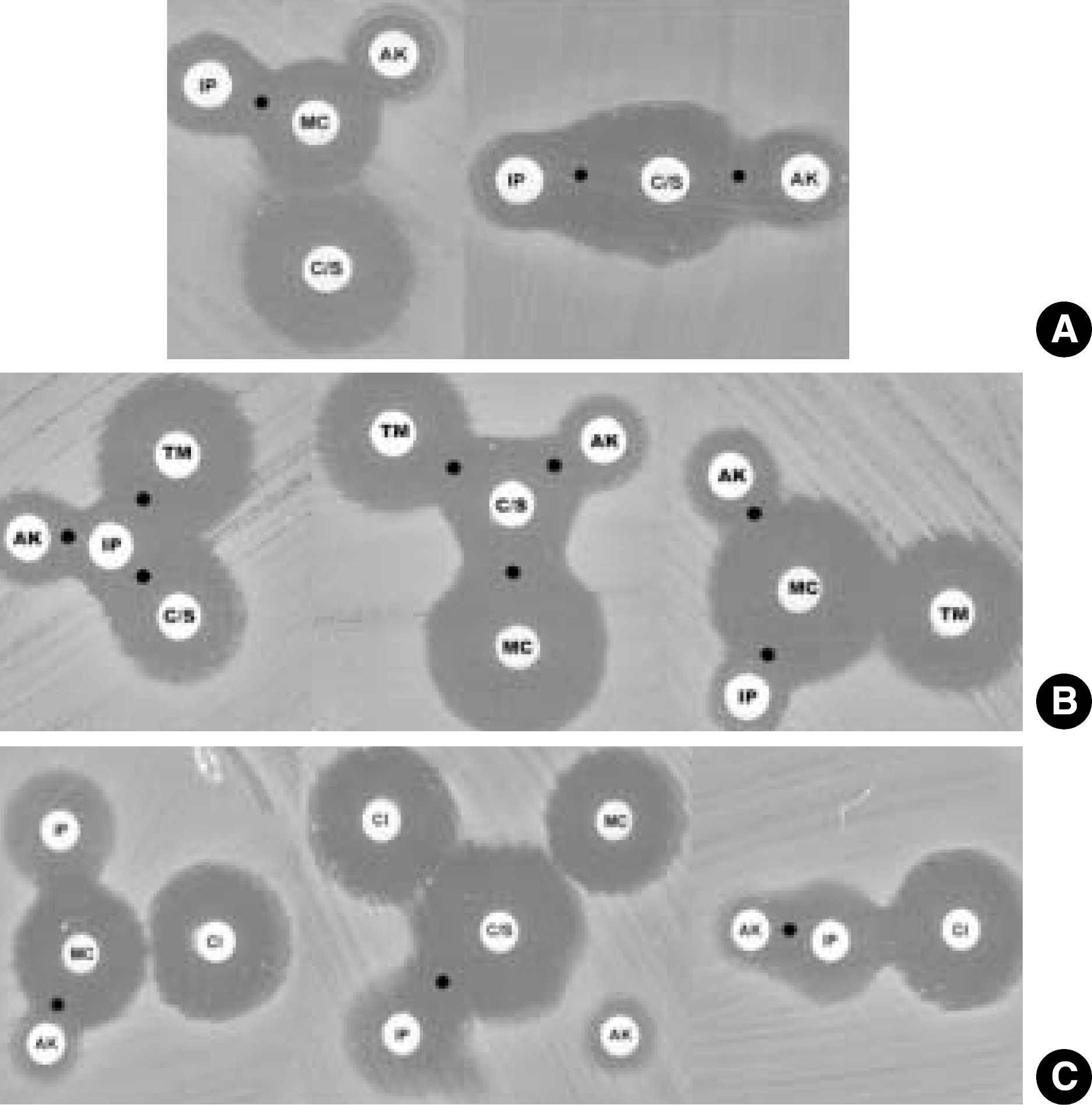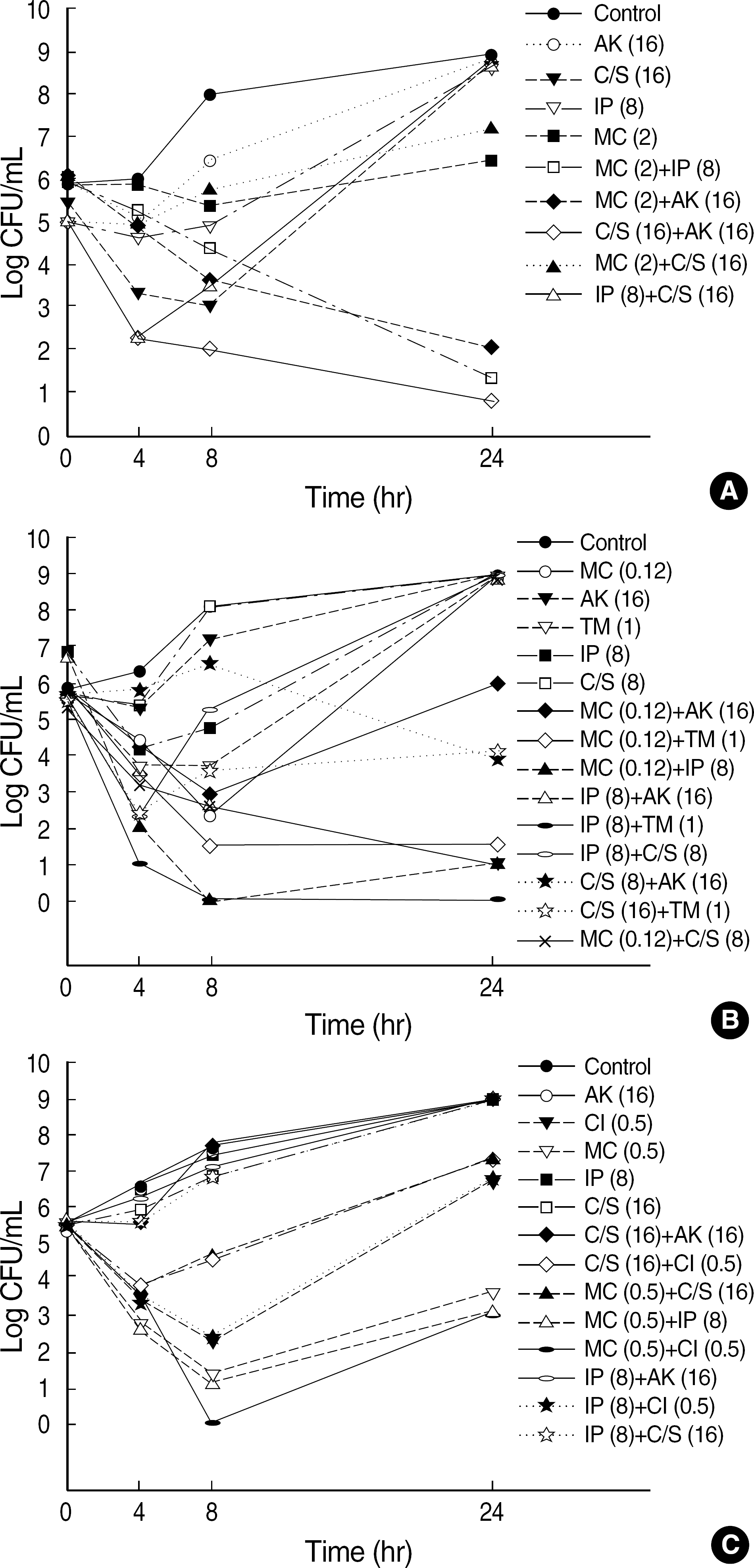Abstract
Background
Most imipenem-resistant Acinetobacter baumannii (IRAB) isolates are multiresistant, leaving few options for an effective antimicrobial therapy. We purposed to select possible candidates for the combinations of antimicrobials that are synergistic in vitro for inhibitory or bactericidal activities against IRAB and evaluate the usefulness of double disk synergy test (DDS) in predicting synergistic bactericidal activity.
Methods
Fifty-five IRAB isolates recovered from patients during the period from August 1999 to November 2000 were tested for susceptibilities to amikacin, gentamicin, tobramycin, piperacillin, piperacillin/tazobactam, cefotaxime, cefepime, cefoperazone/sulbactam (C/S), imipenem, meropenem, ciprofloxacin, levofloxacin, trimethoprim/sulfamethoxazole, chloramphenicol, minocycline, and colistin by the Clinical and Laboratory Standard Institute agar dilution method. Three isolates showing different susceptibility profiles were tested for antimicrobial synergy by DDS and then by time-kill study (TKS) using DDS-positive combinations.
Results
Colistin, C/S, and minocycline were active in 50 (90.9%), 50, and 44 (80.0%) isolates, respectively, and all the other drugs were active in less than 20% of isolates. Minocycline-imipenem, minocycline-C/S, minocycline-amikacin, imipenem-tobramycin, C/S-amikacin, and C/S-tobramycin combinations showed synergistic inhibitory or bactericidal activity by TKS when the same combinations were synergistic in DDS; however, C/S-imipenem was found synergistic on DDS, but not by TKS.
References
1. Afzal-Shah M, Livermore DM. Worldwide emergence of carbapenem-resistant Acinetobacter spp. J Antimicrob Chemother. 1998; 41:576–7.
2. Appleman MD, Belzberg H, Citron DM, Heseltine PN, Yellin AE, Murray J, et al. In vitro activities of nontraditional antimicrobials against multiresistant Acinetobacter baumannii strains isolated in an intensive care unit outbreak. Antimicrob Agents Chemother. 2000; 44:1035–40.
3. Henwood CJ, Gatward T, Warner M, James D, Stockdale MW, Spence RP, et al. Antibiotic resistance among clinical isolates of Acinetobacter in the UK, and in vitro evaluation of tigecycline (GAR-936). J Antimicrob Chemother. 2002; 49:479–87.
4. Oh SJ, Lee SU, Hwang HY, Bae IK, Jo HS, Lee BH, et al. Prevalence of class A extended-spectrum β-lactamases in clinical isolates of Acinetobacter baumannii and Pseudomonas aeruginosa. Korean J Lab Med. 2006; 26:14–20.
5. Murray CK, Hospenthal DR. Treatment of multidrug resistant Acinetobacter. Curr Opin Infect Dis. 2005; 18:502–6.
6. Park AJ, Hong HR. Evaluation of methods for detection of antimicrobial resistance of Acinetobacter baumannii to imipenem. Korean J Lab Med. 2003; 23:388–94.
7. Lee K, Lee HS, Jang SJ, Park AJ, Lee MH, Song WK, et al. Antimicrobial resistance surveillance of bacteria in 1999 in Korea with a special reference to resistance of enterococci to vancomycin and gram-negative bacilli to third generation cephalosporin, imipenem, and fluoroquinolone. J Korean Med Sci. 2001; 16:262–70.

8. Hong SG, Yong DE, Lee KW, Kim EJ, Lee WK, Jeung SH, et al. Antimicrobial resistance of clinically important bacteria isolated from hospitals located in representative provinces of Korea. Korean J Clin Microbiol. 2003; 6:29–36.
9. National Committee for Clinical Laboratory Standards. Methods for dilution antimicrobial susceptibility tests for bacteria that grow aerobically; approved standard-sixth edition, M7-A6. Wayne, Pa: National Committee for Clinical Laboratory Standards;2003.
10. National Committee for Clinical Laboratory Standards. Performance standards for antimicrobial susceptibility testing; thirteen informational supplement, M100-S13 (M7). Wanye, Pa: National Committee for Clinical Laboratory Standards;2003.
11. National Committee for Clinical Laboratory Standards. Performance standards for antimicrobial disk susceptibility tests; approved standard-eighth edition, M2-A8. Wayne, Pa: National Committee for Clinical Laboratory Standards;2003.
12. Bonapace CR, White RL, Friedrich LV, Bosso JA. Evaluation of antibiotic synergy against Acinetobacter baumannii: a comparison with Etest, time-kill, and checkerboard methods. Diagn Microbiol Infect Dis. 2000; 38:43–50.
13. Falagas ME, Kasiakou SK. Colistin: the revival of polymyxins for the management of multidrug-resistant gram-negative bacterial infections. Clin Infect Dis. 2005; 40:1333–41.

14. Falagas ME, Kasiakou SK, Tsiodras S, Michalopoulos A. The use of intravenous and aerosolized polymyxins for the treatment of infections in critically ill patients: a review of the recent literature. Clin Med Res. 2006; 4:138–46.

15. Linden PK, Kusne S, Coley K, Fontes P, Kramer DJ, Paterson D. Use of parenteral colistin for the treatment of serious infection due to antimicrobial-resistant Pseudomonas aeruginosa. Clin Infect Dis. 2003; 37:154–60.
16. Markou N, Apostolakos H, Koumoudiou C, Athanasiou M, Koutsoukou A, Alamanos I, et al. Intravenous colistin in the treatment of sepsis from multiresistant Gram-negative bacilli in critically ill patients. Crit Care. 2003; 7:R78–83.
17. Levin AS, Barone AA, Penco J, Santos MV, Marinho IS, Arruda EA, et al. Intravenous colistin as therapy for nosocomial infections caused by multidrug-resistant Pseudomonas aeruginosa and Acinetobacter baumannii. Clin Infect Dis. 1999; 28:1008–11.
18. Garnacho-Montero J, Ortiz-Leyba C, Jimenez-Jimenez FJ, Barrero-Almodovar AE, Garcia-Garmendia JL, Bernabeu-WittelI M, et al. Treatment of multidrug-resistant Acinetobacter baumannii ventilator-associated pneumonia (VAP) with intravenous colistin: a comparison with imipenem-susceptible VAP. Clin Infect Dis. 2003; 36:1111–8.
19. Kasiakou SK, Michalopoulos A, Soteriades ES, Samonis G, Sermaides GJ, Falagas ME. Combination therapy with intravenous colistin for management of infections due to multidrug-resistant Gram-negative bacteria in patients without cystic fibrosis. Antimicrob Agents Chemother. 2005; 49:3136–46.

20. Michalopoulos AS, Tsiodras S, Rellos K, Mentzelopoulos S, Falagas ME. Colistin treatment in patients with ICU-acquired infections caused by multiresistant Gram-negative bacteria: the renaissance of an old antibiotic. Clin Microbiol Infect. 2005; 11:115–21.

21. Reis AO, Luz DA, Tognim MC, Sader HS, Gales AC. Polymyxin-resistant Acinetobacter spp. isolates: what is next? Emerg Infect Dis. 2003; 9:1025–7.
22. Saugar JM, Rodriguez-Hernandez MJ, de la Torre BG, Pachon-Ibanez ME, Fernandez-Reyes M, Andreu D, et al. Activity of cecropin A-melittin hybrid peptides against colistin-resistant clinical strains of Acinetobacter baumannii: molecular basis for the differential mechanisms of action. Antimicrob Agents Chemother. 2006; 50:1251–6.
23. Suh JY, Ko KS, Jung SI, Park KH, Kwon KT, Park CH, et al. Comparison of antimicrobial resistance among subgroups of Acinetobacter baumannii. Infect Chemother. 2006; 38:323.
24. Wood GC, Hanes SD, Boucher BA, Croce MA, Fabian TC. Tetracyclines for treating multidrug-resistant Acinetobacter baumannii ventilator-associated pneumonia. Intensive Care Med. 2003; 29:2072–6.
25. Urban C, Go E, Mariano N, Berger BJ, Avraham I, Rubin D, et al. Effect of sulbactam on infections caused by imipenem-resistant Acinetobacter calcoaceticus biotype anitratus. J Infect Dis. 1993; 167:448–51.
26. Obana Y, Nishino T. In-vitro and in-vivo activities of sulbactam and YTR830H against Acinetobacter calcoaceticus. J Antimicrob Chemother. 1990; 26:677–82.
27. Wolff M, Joly-Guillou ML, Farinotti R, Carbon C. In vivo efficacies of combinations of beta-lactams, beta-lactamase inhibitors, and rifampin against Acinetobacter baumannii in a mouse pneumonia model. Antimicrob Agents Chemother. 1999; 43:1406–11.
28. Choi JY, Kim CO, Park YS, Yoon HJ, Shin SY, Kim YK, et al. Comparison of efficacy of cefoperazone/sulbactam and imipenem/cilastatin for treatment of Acinetobacter bacteremia. Yonsei Med J. 2006; 47:63–9.
29. Jimenez-Mejias ME, Pachon J, Becerril B, Palomino-Nicas J, Rodriguez-Cobacho A, Revuelta M. Treatment of multidrug-resistant Acinetobacter baumannii meningitis with ampicillin/sulbactam. Clin Infect Dis. 1997; 24:932–5.
30. Pillai SK, Moellering RC, editors. Antimicrobial combinations. Lorian V, editor. Antibiotics in laboratory medicine. 5th ed.Philadelphia: Lippincott Williams & Wilkins;2005. p. 365–440.
31. Lee MA, Moon HW. In vitro activity of antimicrobial combination against multidrug-resistant strains of Acinetobacter baumannii. Korean J Lab Med. 2005; 25:312–6.
32. Choi JY, Park YS, Cho CH, Park YS, Shin SY, Song YG, et al. Synergic in-vitro activity of imipenem and sulbactam against Acinetobacter baumannii. Clin Microbiol Infect. 2004; 10:1098–101.
33. Kiffer CR, Sampaio JL, Sinto S, Oplustil CP, Koga PC, Arruda AC, et al. In vitro synergy test of meropenem and sulbactam against clinical isolates of Acinetobacter baumannii. Diagn Microbiol Infect Dis. 2005; 52:317–22.
Fig. 1.
Double disk synergy tests of three A. baumannii isolates. (A) The isolate 1 showed synergy at the combination of MC+IP, IP+C/S, and C/S+AK. (B) The isolate 2 showed synergy at the combination of MC+IP, MC+C/S, MC+AK, IP+AK, IP+TM, IP+C/S, C/S +TM, and C/S+AK. (C) The isolate3 showed synergy at the combination of MC+AK, IP+AK, and IP+C/S. The black dots denote synergy between the two drugs.

Fig. 2.
Time-kill tests for three A. baumannii isolates. (A) IRAB1 showed synergistic killing at the combination of MC+IP, MC+AK, and C/S+AK. (B) IRAB2 showed synergistic killing at the combination of MC+IP, MC+TM, MC+C/S, MC+AK, IP+TM, C/S+TM, and C/S+AK. (C) IRAB3 showed no synergistic killing at any combination of antimicrobials. The number in parentheses denotes the concentration (μg/mL) of antimicrobials tested.

Table 1.
MICs of 55 A. baumannii isolates against common antimicrobials
Table 2.
Antimicrobial susceptibility and synergy results of the isolates tested by double disk synergy tests and time-kill studies




 PDF
PDF ePub
ePub Citation
Citation Print
Print


 XML Download
XML Download